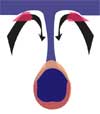
Yemen Traps (Oligocene flood basalt)
at crest of the Red Sea shoulder uplift, southwest
Saudi Arabia near the Yemen border, summit altitude
~2500 m. The basalts correlate with early opening
of the Red Sea near the Afar triple junction,
and in conventional plumology are thought to have
erupted upon a greatly-uplifted region. However,
the basalts overlie more than 100 m of laterite
and saprolite (pale colors), developed over tens
of millions of years from Proterozoic granite,
preservation of which suggests that eruption preceded
uplift and that no plume was involved. Photo by
Warren Hamilton; Hamilton 2 |

Diabase sheets of the Jurassic
Ferrar large igneous province, Antarctica, intruded
into late Paleozoic sandstone that is coal-striped
in its upper part. Each sill is about 300 m thick.
The lower sill is concordant to bedding, and sends
an offshoot into its floor. The upper sill rises
obliquely through the lower sill, and flattens
into concordance at top of cliff. Finger Mountain,
Royal Society Range, Transantarctic Mountains.
Photo by Warren Hamilton. Hamilton 3 |

Lithospheric instability |
